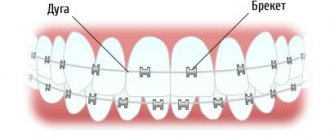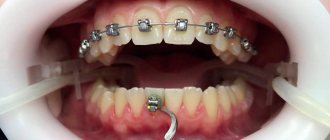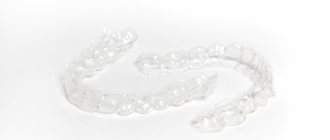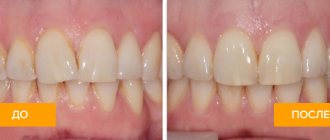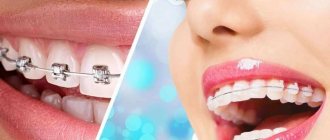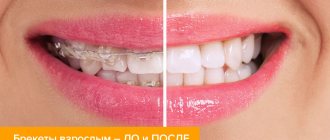What are braces?
Braces, or rather brace systems, are dental structures for eliminating malocclusions and problems with incorrect position of teeth.
Alignment with orthodontic braces began to be practiced back in 1776 in France, but the heavy structures used then interfered with speech and extended beyond the mouth. More than a hundred years later, the device was radically improved in America. Today, the classic system looks different and consists of three main elements: ➢
braces - clasps that are attached to the teeth
➢
orthodontic arch
➢
fastenings (ligatures) for coupling the arch with the clasps
Installation of ligature bracket system
The procedure for fixing the device takes about one and a half hours. What does the doctor do:
- washes the enamel, then thoroughly etches it with a special substance designed for better adhesion of the bracket plates to the surface of the enamel;
- applies an adhesive composition to the areas of future fixation of the plates;
- glues the plates and removes excess adhesive solution;
- threads a power arc into the grooves of the bracket plates;
- fixes the arch with ligatures.
Main types of braces
Previously, when it was necessary to straighten with braces, for many patients the stopping factor was the aesthetic side of the issue - the structures were made exclusively of metal and were fixed on the outside of the teeth. Now there are many types of orthodontic systems to suit every taste. The main differences between braces are the installation methods and materials of manufacture.
External and internal braces
A frequent question from patients is whether it is possible to place braces on crooked teeth without others noticing. Internal, or lingual, braces allow you not to worry about the aesthetic aspect. Unlike external ones, lingual systems are fixed on the back of the teeth and are completely invisible to others. True, the patient takes longer to get used to the lingual system. But it is not always suitable for people with allergies, since it is made of metal, which can provoke an allergic reaction.
Ligature and non-ligature braces
Ligature and non-ligature systems differ in the method of attachment to the arch. The first ones are attached using clamps (ligatures), while the second ones are devices of a more advanced level that do not require additional fastenings. Ligature-free braces allow you to adjust the position of the arch once every 2-3 months. However, many specialists prefer monthly treatment monitoring. Despite their more advanced structure, it is difficult to say that non-ligature dental braces are more effective than traditional ones.
How long should you wear braces?
Another common fear of patients is always the duration of treatment. Despite all the promises of doctors and the testimony of other patients that the installation of the structure has practically no effect on the usual rhythm of life, it is always difficult to decide to correct teeth. It seems like I'll have to wear braces forever!
How long do you really need to wear braces? We have already said that in childhood, treatment is faster due to the characteristics of bone tissue, which is still pliable and ready for rapid changes. Therefore, for children, the period of wearing structures is about 6–12 months, and in complex cases or adolescence it can increase to 1.5 years.
For people 20–30 years and older, the average treatment period is 2 years. The teeth are already firmly fixed in their position, and it will be more difficult to move them from their place.
Don't forget that in dentistry everything is very individual. Your case may be exceptional and require unusual deadlines. It is also possible that the bite will correct itself faster than expected. For example, if self-ligating braces are used. The main thing is not to forget to visit the doctor strictly in accordance with his recommendations, so as not to miss the opportunity to shorten the treatment period.
Types of bracket systems
Some people don’t attach importance to the presence of a metal device in the mouth - back in the 90s, Cindy Crawford not only wore dental braces, but even starred in them in an advertising campaign for Pepsi Cola. For those who have chosen external orthodontic braces, but prefer not to advertise the treatment, there are other options.
Types of braces depending on material
- Plastic: the most budget braces - from 20,000 rubles. It is the plastic design that has become not just a device for dental treatment, but also an accessory that complements the image. Unfortunately, it also has many disadvantages: plastic is not the most durable material, in addition, such dental braces change color under the influence of coloring products.
- Metal: The most durable of all braces for straightening teeth, but they are not suitable for people with metal allergies. A steel system will cost 60,000 - 80,000 rubles, a titanium system - from 80,000 to 100,000 rubles. In terms of aesthetics, this is not the most advantageous design.
- Ceramic: highly aesthetic, matched to the color of the enamel, does not cause allergies, but is less durable than metal. In Moscow, the cost of ceramic braces is 40,000 - 70,000 rubles.
- Sapphire: the most aesthetic of all options. They look very impressive in the light, but if the patient’s teeth have a yellowish tint, you should carefully consider whether sapphire braces are needed, as they will stand out strongly. Also quite fragile. The cost of sapphire structures is 100,000 - 150,000 rubles.
Stage 5: Recommendations after fixing the bracket system
Do your teeth hurt or not after installing braces?
After installing braces, your teeth may or may not hurt. Both situations are normal. Often the next time patients come, they ask the question: “My teeth didn’t hurt, so does that mean my teeth aren’t aligned?” No, this is not true, it’s just individual sensitivity. Most often, patients may experience pain not at rest, but during eating, when biting on the teeth. The normal period is up to 1 week, extremely rarely up to 2 weeks. Please note that there should not be unbearable pain.
What pills should I take?
This can be any drug that usually helps with headaches: Analgin, Nise, Ketanol, any other analgesics. However, it is important to understand that taking these drugs uncontrollably will slow down the movement of teeth - they block the enzyme that is responsible for the restructuring of bone tissue and the tooth slows down its movement. Most patients say that their teeth ached a little, but they did not take a tablet or took 1 tablet on the first day. “I was on pills for a week” in our clinic, not a single orthodontist has encountered this.
Does taking pills affect orthodontic treatment?
When orthodontic treatment is associated with other internal diseases and the patient is prescribed medications that affect bone tissue, this can have a significant impact on the treatment process. A professional orthodontist must understand that in such a situation, the braces system is not always the reason for the slowdown in work, but there are drugs that affect the treatment. It is better for the patient to discuss this with the doctor in advance.
Are there any life hacks to make wearing braces faster and more comfortable?
The arches that are installed after fixing the bracket system are thermoactive. The arches are thermoactive for both ligature and self-ligating braces. Therefore, if you constantly eat ice cream and drink cold drinks, or lower the temperature of the oral cavity, then they do not work. That is, if we want our teeth to straighten faster at an early stage, then it is better not to get carried away with such products. But you can use this information in another way: for example, in the first days after fixing braces, relieve toothache not with painkillers, but by eating ice cream.
Nutrition program in braces or orthodontic “diet”
With braces, you should not eat anything hard - nuts, crackers, or anything sticky and viscous that can stick to the braces and come off - toffee, for example. Apple, meat, carrots - you can eat all this, but you can’t bite it off, you need to cut it into small pieces
Why can’t you tear off the bracket, what’s wrong with that?
By tearing off a bracket and not having the opportunity to re-glue it for a long time, you can get a situation where all the other teeth are aligned, but this tooth takes the wrong position. The second point is that during orthodontic treatment, we change the arches from thin to increasingly rigid. If a patient’s bracket has come off, and within a month he has not found time to visit the orthodontist for re-fixation, then, most likely, this tooth will interfere with placing the next arch - it will not be inserted into the bracket groove. This is a loss of time up to 2 months of treatment. Therefore, we ask patients to be careful.
What to do if the bracket comes off?
If this happens, then it is better to come within 2-3 days, a maximum of a week, to glue it. If the patient is on vacation, this should be done immediately upon return. If one of the braces on the front teeth has come off, it will simply hang on the arch. This usually does not bring any discomfort. If the last bracket (lock) has come off, then, given that it has no support behind it, it will end up in the oral cavity. And the patient’s task is to try not to swallow it or throw it away. It is not damaged in any way, so you can bring it to the orthodontist, and he will process it and fix it on the tooth again.
What happens if you swallow a brace?
Nothing bad will happen to your health; the brace itself is small and does not have sharp edges that could damage the gastric mucosa. You will simply need to install a new brace during a visit to the orthodontist.
Can braces chafe?
This shouldn't happen. If there is discomfort, it means something has happened to the archwire or the bracket has come off. In this case, you need to visit an orthodontist, and he will easily correct everything, cut or bend the arch.
Wax for braces
Discomfort in the mucous membranes of the cheeks or lips is possible while getting used to braces, but not often. Orthodontic wax helps alleviate discomfort. Essentially, this is “plasticine” that softens in the patient’s fingers and sticks to the place that scratches: to the bracket, arch, hook. You can cover everything that is in your mouth and that causes discomfort. It is important to first take a cotton pad and dry the area where you want to glue the wax. This wax is food grade, so if it falls off and you swallow it, nothing bad will happen. At the Confidence clinic, we always give wax to patients after fixing the braces.
Are there speech defects when wearing braces?
They cannot be with external braces. The more the patient talks, the faster the adaptation occurs, but this is more typical for internal braces. Orthodontists at our clinic recommend that patients with lingual braces read aloud for a few days after fixation for quick adaptation.
How do braces differ from each other?
| Type of braces | Materials | Differences | Price |
| Metal | metal alloy | reliable and cheap | from 50,000 rubles* |
| Ceramic | ceramics | the most inexpensive of aesthetic | from 70,000 rubles* |
| Sapphire | artificial sapphire | beautiful and relatively inexpensive | from 100,000 rubles* |
| Lingual | gold + metal | completely invisible | From 150,000 rubles* |
*Prices are indicative in Moscow and only for the bracket system.
How do braces straighten teeth?
It is designed by nature that our teeth can change position - independently or under the influence of external forces. Thanks to this property, orthodontic treatment with braces becomes possible. Its principle is the following.
- Based on the patient’s clinical picture, the doctor plans a trajectory of movement for each tooth; one bracket is responsible for one dental unit.
- During the process of fixing the braces, the clasps are connected to each other by an arch with shape memory, which it tends to take over time.
- Under the influence of the arc, the dentition begins to take the desired position.
- During treatment, the archwire is replaced with a more rigid one to increase the impact.
How can a patient feel after having braces installed?
How painful the sensations will be in the first days after the start of orthodontic treatment largely depends on the individual characteristics of the patient. Some may experience only mild discomfort from the device in the mouth, while for others, on the contrary, the pain can be so severe that it prevents them from falling asleep.
What a patient may encounter after installing braces:
- Burning sensation in the gums
. This is due to the fact that the tooth, changing its position, slightly injures the soft tissues. It's similar to when a tooth breaks through the gum. Everyone has experienced this feeling at some point.
- Pressure on teeth
. Usually it does not cause severe discomfort and the patient gets used to this effect. At first the pressure is stronger, gradually it subsides and intensifies again when the arc changes.
- Sharp sharp pain
. This can occur if you put too much pressure on a tooth that has braces installed on it. Such exposure usually causes cheekbones to tighten and tears to appear in the eyes. But such pain goes away immediately if you stop putting pressure on the tooth.
- Mild pain of unknown origin
. It usually appears in the first day after installing braces and can last for a long period. It most likely occurs due to fatigue in the oral cavity due to the pressure exerted by the orthodontic apparatus.
- Unpleasant sensations on the inside of the cheek
. This is due to the fact that braces rub against mucous membranes and can scratch them.
Again, experiencing some discomfort and pain immediately after installing braces is normal from the point of view of orthodontists. But it is abnormal and unnatural from the point of view of any realistically thinking patient. But in this case, there is no choice, and if the pain is severe and does not subside, then, most likely, the braces are installed either incorrectly and you should urgently consult a doctor, or you need to be patient (but also consult your doctor first).
Correct your bite or dental defect with invisible aligners Find out what it is
Indications and contraindications for installation
Problems that alignment with braces can help solve:
- crooked teeth due to improper growth
- displacement of the dentition as a result of the removal of dental units
- jaw development disorder
When there is crowding and gaps between teeth, braces are the optimal solution. In the latter case, it will not be possible to manage with orthodontic treatment alone; complex procedures with the participation of a surgeon will be required.
At what age are braces placed?
The mobility of teeth in the jawbone persists throughout a person’s life, therefore, the answer to the question “Can braces be placed on crooked teeth in adulthood?” - positive. However, correcting a child’s bite with braces is much easier.
You can begin treatment as early as 9 years of age, even if not all baby teeth have been replaced by permanent teeth. The most optimal age for installing braces is 12 - 13 years old, but even at 30, braces will show good results. It will just take more time.
Braces for crowns, veneers, implants
Crowns are not a contraindication to orthodontic treatment. The best option for installing braces on crowns is a metal system. It will provide reliable adhesion to the artificial material of the prosthesis. If you need to install a brace system on the teeth that serve as support for the bridge, the doctor will simply remove the prosthesis and put temporary plastic crowns on the patient for the period of treatment.
As for veneers, if they are already on the teeth, this will not be a contraindication to installing a brace system. However, it is still better not to install veneers before braces, especially taking into account that an incorrect bite is, in principle, a contraindication to veneering.
With an implant, it is already more difficult to correct the bite with braces - the artificial root sits firmly in the bone and is not able to move except upward. If possible, it is better to correct the curvature of the dentition before installing an artificial root. However, if implants are already in place, orthodontic treatment can still be planned and successfully carried out.
Stages of treatment with braces
Correcting a bite with braces takes place in several stages:
- Preparation for orthodontic treatment - obtaining x-rays, OPTG, TRG and others. The doctor will also refer you for treatment of caries and pulpitis if he diagnoses signs of dental problems. Additionally, professional teeth cleaning and, in rare cases, removal of individual teeth are indicated.
- Fixation of the bracket system. The doctor will attach the plates under the arch on the patient’s teeth and install a wire of a suitable diameter and shape. During the treatment process, the orthodontist will gradually increase the diameter of the arches, and at the final stage, use a rigid rectangular wire.
- Removal of braces and retention period. The last stage is necessary to secure the position of the teeth in the correct positions. To do this, the patient is given a non-removable retainer on the sublingual side or night guards are prescribed.
The duration of treatment with braces depends on many factors - the complexity of the pathology being corrected, the anatomical characteristics of the patient, and the selected brace material.
Braces for extracted teeth
It is possible to install an orthodontic structure in the absence of one or more teeth, but it depends on the specific clinical picture. For example, it is quite possible to straighten a slight curvature in the frontal zone, even if there are no molars in the row. But is it possible to use braces to close a void when supporting teeth are missing? In this case, installing a system makes sense only if we are talking about 6, 7 and 8 teeth. If the figure eight (wisdom tooth) is missing, movement is impossible, since the chewing teeth will not be enough for full functioning.
Braces for one jaw and several teeth
If the patient is concerned about the curvature of, for example, only the upper teeth, fair questions arise. For example, why do you need braces on two rows of teeth? And do they put braces on one jaw? Installing only upper braces or only lower braces is indeed possible in the absence of global problems. It is important that the treatment gives an effective result without affecting the function of the jaw.
If a patient has several crooked teeth in one area, the doctor may suggest partial dental braces. They are installed on a specific area of the dentition for about six months.
How much do braces cost?
Indeed, dental correction cannot be called very affordable. However, we are doing everything to provide this opportunity to those who need it. With us you can get comfortable installments and choose a system from different price segments. Sometimes it is advisable to choose more expensive braces for one jaw and install a cheaper design on the other.
In the price list you will find a complete list of designs. But it’s better to talk about this with your doctor - he will tell you what is right for you, how long you will need to wear braces and how much you will have to spend on it. For example, the most technologically advanced Damon self-ligating braces, which reduce treatment time by 20–30%, cost a little more.
It is worth understanding that the total cost of treatment includes regular visits to the doctor, professional cleaning, replacement of locks and other issues.
Remember - any doubt can be resolved in consultation with a doctor!
Contraindications for installing braces
The installation of braces on teeth can be hampered by relative and absolute contraindications.
Relative contraindications to braces can be eliminated. These include:
- low level of hygiene
- caries
- allergy to materials contained in braces
- periodontitis, periodontal disease
- bruxism
Absolute contraindications are serious health problems that make orthodontic treatment impossible. These include:
- oncological diseases
- epilepsy
- psychiatric disorders
- pathology of bone tissue
- alcohol and drug addiction
- venereal diseases
- blood diseases
- tuberculosis
- diseases of the immune and endocrine systems
Stage 4: Fixation of the bracket system using the indirect fixation method
To install braces, there is a basic standard protocol for direct fixation of oral braces, which is very common in Russia - braces are glued “by eye” without carefully checking its position, which is easier and faster for a specialist.
The expert group of orthodontists at the Confidence clinic uses a progressive protocol for fixing braces based on the best techniques of recognized Italian and French specialists in orthodontics. The key feature of this protocol is indirect fixation, which has obvious advantages in terms of accuracy and patient comfort.
Indirect fixation is the most progressive method now, which is already actively used by European orthodontists. When the doctor has a model of the patient’s teeth in his hands, and before his eyes are his pictures and photographs, the doctor has the opportunity to impeccably accurately outline each tooth, mark all the axes on it and place the bracket in the most correct position. This can only be done accurately on a model, and not in the oral cavity, where soft tissues may interfere. In addition, the patient does not need to spend several hours in the doctor’s chair.
The second advantage for the patient is that the braces are not glued individually. If this is done carefully, then even an experienced doctor will take a lot of time not even to fix the bracket on the tooth, but to check its position from all sides. With indirect fixation, the speed and comfort of installing braces is reduced by 2-3 times. Patients often ask how long does installation take? For one jaw - about 1 hour, for both jaws - an average of 1.5 hours. This does not mean that the procedure itself lasts that long - most of the time is spent talking with the patient and detailed recommendations.
How is braces fixed technically?
- 1. The tooth is treated with gel, then a special varnish is applied. In this case, the tooth is never treated with bur and the enamel is not sanded off.
- 2. Braces are fixed on the tooth surface with orthodontic filling material.
- Between the bracket and the enamel, adhesion occurs - gluing.
- On the last teeth in the row there are locks into which the arch is inserted.
- Next, an arch is inserted into each bracket, if it is Damon or Insignia, by pressing on the groove and the lid is closed in turn from the center to the sides.
- If these are ligature braces, then the arch to each bracket is a metal or elastic ligature. This is the main disadvantage of ligature braces, because the ligature, especially elastic, loses its properties over time, stretches and ceases to adequately hold the arch in the bracket, and it is the arch that is the driving force.
- After closing the braces, it is also necessary to install special stoppers on the front braces.
The procedure is absolutely painless. To eliminate possible discomfort from dry lips, always apply a moisturizer first.
How are lingual braces fixed?
Lingual and any other braces with digital technologies (Insignia, Win, Incognito) come to the clinic ready-made in a tray. They are already located in the position in which the computer program positioned them. This is the same indirect fixation technology that is used to install all brace systems at the Confidence clinic.
Why do you need an orthodontic arch?
If you simply glue braces to all your teeth, there will be no tooth movement.
A brace does nothing to the tooth. A brace is a small computer that contains information about how the tooth should stand. He can't do this without an arc.
The bracket contains information that is not realized in any way on its own. How well the embedded information is implemented depends on how tightly the arch is placed in the bracket. If these are ligature braces, then with a greater degree of probability, a week or two after installation, the ligatures will stretch, which is not very good for treatment.
Why do you need stoppers on braces and what can their absence lead to?
Often patients come to us from other doctors whose stoppers are not tight. If the bracket system does not have ligatures, but only bracket covers, then the arch can easily slide in the grooves and, despite the fact that the covers are closed, will move to the right and left. Shifting, the sharp end of the arc can rest against the cheek. To prevent this from happening, you need a stopper - a metal cap on the arc. It is tightly fixed in such a way that it rests on the braces on both sides and prevents them from moving. This is guaranteed protection against unpleasant sensations on the mucous membrane.
How do we protect our patients from discomfort when getting braces?
When installing the first arch, our orthodontists do not attach the orthodontic arch to the very last bracket on the seventh tooth. The fact is that usually the first arch is very thin and does not have enough strength to move a powerful tooth with large roots. And the distance between this and the neighboring, sixth, tooth is usually quite large, in which case a thin arch can jump out and scratch the soft tissue of the cheek.
In addition, after closing the last bracket, the orthodontist bends the arch with a loop 90 degrees. This is another factor in protecting the patient from mucosal injuries. By bending the arch into a rounded loop, the orthodontist minimizes discomfort and the risk of injury to the patient’s mucosa, even if the arch begins to protrude.
When are bends applied to the bracket system archwire?
Curves are applied to a rigid arch, closer to the middle or end of treatment, when the dentition is already more or less even. Most often this happens 8 months after the start of treatment. It is very rare that bends are applied to soft arches, but such manipulations are aerobatics; not all orthodontists are proficient in this technique.
Why are bends on an orthodontic arch needed?
Despite the fact that we use indirect fixation of the bracket system, which ensures maximum accuracy of the position of each bracket on the tooth, even indirect fixation has some error. The first stage at which we begin to solve the problem of this inaccuracy is the plywood stage. After about 4-6 months, when the teeth are almost aligned, we take an orthopantomogram in order to evaluate the alignment of the roots of the teeth as well. We remove some braces and fix them in a new position, focusing on the image and the evenness of the teeth in the mouth, which is a very important point on the path to ideal evenness of the teeth. The fact is that the parallelism of the roots after teeth alignment is the key to the stability of the result. An unevenly located root can cause crooked teeth after the braces are removed. The most experienced lecturers, including Western ones, say that they re-glue their braces a lot, which is one of the secrets of their success. However, in addition to the inaccuracy of the position of the bracket on the tooth, there is also some loss of information embedded in the bracket. The arch should fit into the bracket as tightly as possible. If the arch completely repeated the dimensions of the space inside the bracket for it, then it would be impossible to insert it there. In order for all the information to be realized and the teeth to become perfectly straight, we apply bends to the arches.
What are the methods for final correction of the position of individual teeth?
There are two options: re-glue the bracket to a new position or use arc bends to bring the teeth to the ideal position.
Can a brace be crooked?
Sometimes patients say that the bracket is crooked and not in the center of the tooth. In principle, braces are not placed in the center of the tooth; they are placed at special points and parallel axes. This may look like a strong shift to the edge of the tooth - to the right, to the left, a little higher, a little lower. This placement is done deliberately according to calculations; this is not an orthodontist’s mistake.
Can I wear braces during pregnancy?
During pregnancy, women's dental tissue becomes more fragile, and there is a risk of damage to it by orthodontic construction. Can braces be installed during this period? Yes, but ideally it is better to have orthodontic treatment before or after pregnancy. If you already have braces on your teeth, you should definitely inform the orthodontist about the changes in your body. The doctor will prescribe a detailed diagnosis and decide whether braces and pregnancy are compatible.
If everything is in order, treatment with dental braces can be continued as usual. If the effectiveness of orthodontic treatment is questioned, the specialist will recommend removing the system and using retainers until the process can be resumed.
Stage 2: Treatment Plan
After diagnosis, the orthodontist needs about a week to analyze all the material, make calculations and draw up an individual treatment plan.
There can be one or several treatment plans. Each of them may have its own characteristics, pros and cons. The orthodontist most often voices the treatment plan that he is inclined towards and considers the most optimal in this case.
The patient can choose any of the proposed treatment plans, realizing the difference between them and understanding the doctor’s point of view. After the patient and the doctor have agreed on one of the plans, the choice of braces occurs - this is a strategic issue in which the patient and his attending physician must come to a consensus.
Result of wearing: before and after photos
The effect of wearing an orthodontic system is noticeable already in the first two months - gross violations are corrected. Next, the position of the teeth and roots is normalized. By about the eighth month, the entire dentition can be corrected with braces; the next stage begins—correction of the bite with braces. During the final stage, the teeth are “worked out” in detail so that they fit together perfectly.
The course of treatment does not end with removing braces. Next, the doctor uses special structures to stabilize teeth after braces - retainers. The device is installed on the inner side of the dentition for 2 - 4 years. The duration depends on the age of the patient (the younger he is, the shorter the period of wearing retainers) and the severity of the anomaly.
In some cases, orthodontic systems have a positive effect on more than just the position of teeth. After braces, the face becomes more toned and the cheekbones become more pronounced. While wearing the structure, other muscles begin to work, emphasizing what was not noticeable before.
Teeth after braces
Many patients fear the negative consequences of braces. It is known that dental braces complicate oral hygiene procedures. However, following the doctor’s instructions for dental care during the treatment period will help avoid exposure to carious bacteria. If caries does appear, in most cases the specialist will be able to carry out treatment without disturbing the braces.
When removing sapphire or ceramic braces, damage to the enamel is possible - during the procedure they can crumble, which significantly complicates the orthodontist’s work. If damage occurs, the defect can be easily corrected with a small restoration.
Stage 3: Sanitation and oral hygiene
Sanitation includes the treatment of caries, pulpitis, periodontitis, including those teeth that do not bother the patient today. Sometimes old fillings that have ceased to perform their function also require replacement. Some teeth may require removal, but we strongly recommend that you do not make this decision on your own.
We often come across the fact that patients, when they come to see an orthodontist, have already had their teeth removed in advance. There is no need to do this! Very often, for effective orthodontic treatment, it is better to remove teeth during the treatment process only six months or a year after it begins.
If you have already undergone sanitation in advance, then it is enough to provide your orthodontist with a certificate of sanitation and undergo a free follow-up confirmation consultation with a dentist-therapist at the Confidence clinic.
After therapeutic sanitation, it is necessary to carry out professional oral hygiene with special training in proper hygiene with braces. Hygienists also individually select hygiene products and items for patients: brushes and brushes that are suitable specifically for this patient
How to fix crooked teeth without braces?
Today, dentistry offers several alternative solutions that allow you to straighten teeth without braces:
- Restoration: correction of defects in the dental crown using composite materials. Provides quick results at an affordable price, but will last about five years, and the color of the material will change over time.
- Veneering: fixation of plates on teeth that are almost indistinguishable from natural enamel. The method is used instead of braces for small curvatures or large gaps and is not suitable if the patient has complex dental curvature or malocclusion.
- Installation of removable braces. Essentially, these are orthodontic structures that do not need to be worn constantly. However, calling them braces is not entirely correct; these are completely different systems.
Are there removable dental braces?
Removable orthodontic systems are divided into trainers, plates and aligners. However, only the latter can be considered an alternative to braces.
Aligners are special aligners made of plastic material that are invisible to others. They are able to quickly and comfortably correct almost any dental defect. The aligners are removed when eating and brushing your teeth, which is very convenient. The Invisalign® system is considered the best today - it allows you to cope with defects that previously could not be straightened without braces. The design is made individually for each patient, so its cost is quite high and amounts to about 250,000 rubles.
Despite the many positive qualities of removable systems, the patient should make the decision about whether to install braces or use other correction methods only together with the attending physician.
Why are teeth crooked?
It is possible to correct crooked teeth with braces, but patients have a question: why are their teeth not perfect?
There can be many reasons for the curvature of the dentition:
- Genetic predisposition
. If the parents had a deficiency, then there is a high probability that it will manifest itself in the baby. - Incorrect teething may result from using incorrect feeding bottles. It is worth using only pharmacy options with a certain arrangement of holes and justified rigidity.
- Habits from childhood
. You should not constantly give your baby a pacifier. It is unacceptable to reinforce bad habits - biting your lip, sucking toys or fingers. Psychologists recommend distracting and redirecting children’s attention. - Lack of stimulus for the development of the jaw apparatus. You cannot feed a baby only from a bottle after 1 year of life; the hole in the nipple should not be large. Otherwise, hard tissues and gums are formed without the necessary load, and teeth may erupt crookedly.
- Mouth breathing
. A very serious systemic factor leading to malocclusion in both childhood and adolescence.
Sometimes the cause of crooked teeth is ENT diseases. Nasal breathing is impaired, complications arise after illnesses, the child breathes through the mouth, as a result of mouth breathing, the dental arches narrow, and the dental units become crowded. And then the problem can be corrected with the help of braces when the baby grows up. At an earlier age, plates and even aligners are successfully used - they are currently recommended for use starting from the age of 6.
Curvature of teeth can begin in adolescents and adults after abnormal eruption of wisdom teeth or weakened immunity as a consequence of serious illnesses. Then you need to make an appointment at the clinic with a doctor who will recommend installing braces or choose another correction method.
Do's and don'ts when straightening teeth with braces
Orthodontic treatment is a long and responsible process. At home, braces require compliance with a number of rules.
- Hard and sticky foods should be excluded from your diet to avoid damaging your dental braces or getting food stuck in them.
- Sudden changes in temperature in the oral cavity should not be allowed (that is, ice cream should not be washed down with hot tea). This affects the elasticity of the orthodontic arch and can lead to the clasp coming off.
- To prevent ceramic or plastic braces on your teeth from staining, you should avoid coffee, jam, wine and drinks with dyes. Smoking also causes the system to change color.
- The oral hygiene procedure should be carried out using an irrigator, floss (dental floss) and a special brush with V-shaped bristles. Oral care is necessary after every meal.
- If the braces are loose or come off, there is no need to worry - just consult a doctor, and he will easily and quickly correct the situation.
At first, after you start correcting your teeth with braces, all these restrictions may seem quite burdensome and make you think: was it worth getting braces? However, the patient gets used to them very quickly. In addition, the result of the treatment definitely justifies all these not so pleasant nuances.
Important!
Is it possible to do an MRI with braces? If a patient with an orthodontic device is undergoing an MRI of the brain or jaw, the doctor should be informed about the presence of the system. Metal braces can distort diagnostic results. However, undergoing an MRI in braces does not pose any danger to the body.
How to wear and care for braces?
For those who have made the right choice and decided to correct their teeth, the doctor will give personal recommendations on how to care for the oral cavity during treatment.
The main recommendation would be proper hygiene and reasonable dietary restrictions. For example, when treating a malocclusion, you should refrain from sharp temperatures of food and drinks, and exclude very hot and very cold foods. You should also not gnaw on fruits and vegetables or crack nuts - all this can move the locks and damage the structure. If there is any violation of the position of the braces, you will need to consult a doctor for correction.
Braces place responsibility on the patient. The duration of treatment and the condition of your teeth after removing the braces system depend on how well you observe hygiene and rules. As for brushing your teeth at home, it will take a little longer. It is necessary to use special devices to clean the enamel around the locks after each meal. In addition, the orthodontist prescribes professional cleaning in the clinic to all patients at the required frequency. This way you will protect your teeth from caries, because the risk increases if you do not pay due attention to hygiene. In general, oral care tips will be quite simple. All patients quickly get used to the new rules and even stop noticing that they spend 5-10 minutes more on dental care.
Next, we will answer the last, but very popular question: how much do braces cost? In our clinic, patients have a fairly large selection of systems from different manufacturers. The cost of treatment depends on the materials and type of structure, as well as the timing of wearing braces.
Photos before and after
It is impossible to create a truly Hollywood smile without straightening your teeth and correcting your bite. Therefore, if a patient has orthodontic problems, braces are included in the mandatory treatment plan. Incorrect bite and crooked teeth are one of the main contraindications for the installation of aesthetic restorations. If you ignore orthodontic treatment and proceed straight to veneering, the veneers simply will not stick to the teeth. This fact is confirmed by personal example by many celebrities who, for the sake of a perfect smile, put braces on their teeth.
Tom Cruise decided to fix his teeth with braces only after 40 years.
After the breakup of the Spice Girls, Melanie Jane Chisholm had to seriously work on her image, and, above all, straighten her teeth.
Cristiano Ronaldo was not always handsome, as his impeccable smile might lead you to believe. According to rumors, he spent more than a million euros on teeth straightening and other procedures.
Why pain in braces is “normal”
Painful sensations tell us that the tooth is being impacted. This is how it moves. This process involves both soft gum tissue and the bone base of the jaws.
And if soft tissues easily adapt to the new position of the tooth and heal quickly, then bone tissues cannot change so quickly and hurt longer.
It is important to understand that this pain is not associated with the destruction of the tooth, but with its movement to a new, even position.
Interaction with the iron ligature of braces can also cause small ulcers in the mouth that irritate. Such irritation and even damage to the mucous membranes is caused by the metal parts of the brace system. These wounds go away quite quickly after the oral cavity adapts to the device. But they may not pass, as for example in this case:
We can say that the mucous membrane adapts to such external effects of metal. As they say, everyone has to get used to and come to terms with the fact that now they will have to wear braces on their teeth for a year or two.
Price for braces in Moscow
As a rule, the cost of braces in Moscow is formed from the price of the system itself, as well as the total costs of installation and further treatment. The cheapest braces are, of course, metal. Their price starts from 50,000 rubles. Relatively inexpensive ceramic systems that cost about 75,000 rubles. The cost of a sapphire bracket system starts from 85,000 rubles. You need to be careful here, as ceramics are sometimes passed off as sapphire. The most expensive will be lingual systems, especially if they are made to order, their approximate price starts from 100,000 - 150,000 rubles. When figuring out the cost, be sure to ask what is included and what services will need to be paid additionally. It happens that the initially low price of braces increases significantly during the treatment process. However, when choosing an orthodontist and a braces system, you should not focus solely on cheaper or more expensive; remember that poor-quality orthodontic treatment is fraught with a lack of results and the occurrence of a number of complications.
| A country | Manufacturer | Manufacturing materials | Price |
USA | 3M Unitek | Metal braces | from 25,000 rubles |
| Ceramic braces | from 70,000 rubles | ||
| Sapphire braces | from 80,000 rubles | ||
| Ormco | Metal braces | from 20,000 rubles | |
| Ceramic braces | from 45,000 rubles | ||
| Sapphire braces | from 50,000 rubles | ||
| American Orthodontics | Metal braces | from 40,000 rubles | |
| Ceramic braces | from 70,000 rubles | ||
| Sapphire braces | from 50,000 rubles | ||
| Ortho Technology | Metal braces | from 15,000 rubles | |
| Ceramic braces | from 35,000 rubles | ||
| Sapphire braces | from 40,000 rubles | ||
| The Dentsply GAC | Metal braces | from 20,000 rubles | |
| Ceramic braces | from 30,000 rubles | ||
Germany | TOP-Service für Lingualtechnik GmbH | Gold-platinum alloy braces (lingual only) | from 175,000 rubles |
| Forestadent | Metal braces | from 30,000 rubles | |
| Ceramic braces | from 60,000 rubles | ||
| Sapphire braces | from 90,000 rubles | ||
Korea | HT Corporation | Metal braces | from 20,000 rubles |
| Sapphire braces | from 30,000 rubles | ||
Italy | SIA Orthodontic | Metal braces | from 20,000 rubles |
| Ceramic braces | from 25,000 rubles | ||
Correction of distal bite with braces
Who do we work for?
- Who has dental and orthodontic problems
- Who has general body problems
- Who is tired of going to doctors to no avail?
- Whoever is scared by the sentence “operation” - we will try to help without surgery
And one more thing... Literally all the “affected” patients, who were promised to cure their distal bite only with braces, were not diagnosed (or were carried out very superficially) before they were “placed” with those same braces. And diagnostics is precisely the very event with the help of which the cause, mechanism of occurrence, level and scale of any dentofacial anomaly are revealed (see About diagnostics in Orto-Artel). And since it was not done, then, in the end, this is the reason for all the failures and “misunderstandings.”
Diagnostics is the first step in the treatment of distal occlusion Do you want to know why it’s impossible to do without diagnostics?
Therefore, Oto-Artel specialists responsibly declare: in order to avoid failures in correcting distal occlusion, it is necessary to know and understand several fundamentally important things.
1. Distal occlusion is always a combined, multi-level anomaly. This is always a symptom complex.
There is always a skeletal part of the distal bite (and it is the main and priority in terms of elimination). And there is a “dental” part of it (and it is this that serves as the “motive” for contacting an orthodontist). And it is only the “tooth” part that can be eliminated with the help of braces. But do not confuse cause and effect. Main and secondary. This is fraught...
In addition, since distal occlusion is a combination of many problems at different levels (teeth, posture, jaws, etc. - see Distal occlusion), then ideally it should be eliminated in a comprehensive manner. As is customary in “Orto-Artel” (see The treatment concept of “Orto-Artel”)
Treatment in installments
The Orto-Artel clinic offers installments for the entire process of treating any disease. Personal conditions are considered on an individual basis.
Find out more
or call 8 (495) 128-11-74
2. It is impossible to correct malocclusion with only one device. Incl. “only with braces.”
Treatment of distal occlusion is always a multi-step process. And each stage has its own goals and objectives. And your own apparatus (devices) for their implementation.
How we are working
we have two basic operating principles that are logically related to each other
- 1
etiotropic treatment
we treat not the effect, but the cause
- 2
systematic and integrated approach
for dental problems, you often need to seek help from an osteopath, and for general problems of the body, you need to seek help from a dentist
IF YOU AGREE WITH THIS, ORTO-ARTEL IS WAITING FOR YOU
3. The use of braces is a mandatory stage in the treatment of distal occlusion. But this is only ONE of the stages... And it is usually final...
Before using braces in the treatment of distal occlusion (at the “dental” stage of treatment), it is always necessary to first eliminate the skeletal causes of this anomaly. In particular, to normalize the position of the lower jaw and the size of the dentition. For this purpose, completely different devices are used...
4. Distal occlusion in 99% of cases is treated without tooth extraction or surgery
This is evidenced by the experience of Orto-Artel specialists. Over the past five years, not a single one of our “distal” patients has gone to surgery. Because a successful “compromise” was found for them. And in only two cases (and this is less than 0.5% of all cases) treatment with the removal of teeth was indicated (but even then, not “fours”, but “sevens”).
In addition, even if the patient falls into the “surgical” one percent, in 100% of cases orthodontic preparation for surgery and rehabilitation after it are necessary.
5. Without diagnosis, planning and treatment of distal occlusion is impossible in principle
Since it is impossible “by eye” to identify the cause, mechanism and level of occurrence of the anomaly. And also its scale.
If you have been offered treatment for distal occlusion simply by “looking” at your photographs and “casts”. Or they even decided to treat you “by eye”. And also, if you were told that the treatment of distal occlusion in your case will involve tooth extraction or surgery. Equally, if you were offered to correct your distal bite simply by “putting braces”...
There is reason to think!!!
The success of treatment depends 100% on correct diagnosis. We guarantee high-quality diagnostics.
Experience shows that such proposals do not come from great “thought.” There is a risk that they simply did not want to “dig deeper”…. They approached it “superficially”... After all, it is always more convenient to treat according to the “standard scheme”. Not taking into account that such treatment does not take into account the individual characteristics of the person (patient).
This does not happen at the Orto-Artel clinic. We always treat distal occlusion individually and comprehensively. Without unnecessary “dental removal” and surgery... Make the right choice!
Prices for correcting distal bite with braces
| General: | |
| Initial consultation with a dental specialist (30 min.) | 1,500 rub. |
| Extended consultation with a dentist (over 30 min.) | 2,000 rub. |
| Consultation with a dentist with a description of the CT scan, drawing up a preliminary examination and treatment plan | 3,500 rub. |
| Diagnosis of distal occlusion before treatment with braces: | |
| Primary diagnosis (two visits) First visit: taking impressions, making plaster models, photos. Analysis of jaw models, multisystem analysis of lateral TRG, OPTG analysis, photometry, diagnosis, development of a treatment plan. Second visit: announcing the results to the patient and discussing the treatment plan with him | from 18,000 rub. |
| Additional diagnostics | from 40,000 rub. |
| Diagnostics in the articulator | from 8,000 rub. |
| Postural diagnostics Read more about diagnostics in our clinic | 4,000 rub. |
| Correction of distal bite (orthodontics): | |
| Treatment with an orthodontic plate | cost from 30,000 rub. |
| Splinttherapy | from 80,000 rub. |
| Treatment with aligners | from 200,000 rub. |
| Installation of braces | from 120,000 rub. |
| Installation of braces for adults | from 120,000 rub. |
| Installation of ceramic braces | from 120,000 rub. |
| Installation of metal braces | from 120,000 rub. |
| Installation of lingual braces | from 120,000 rub. |
The prices shown are indicative only. The volume and cost of treatment is determined by a specialist only after diagnosis and drawing up an individual treatment plan.

